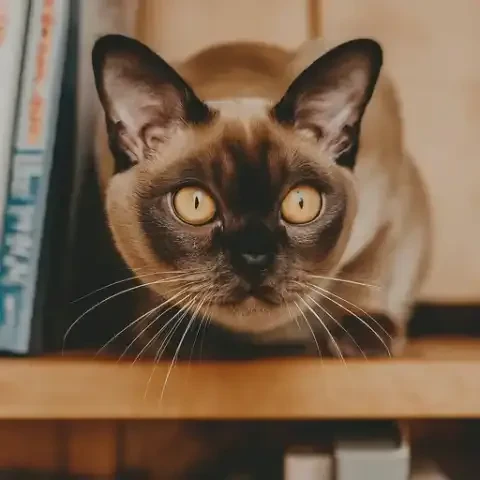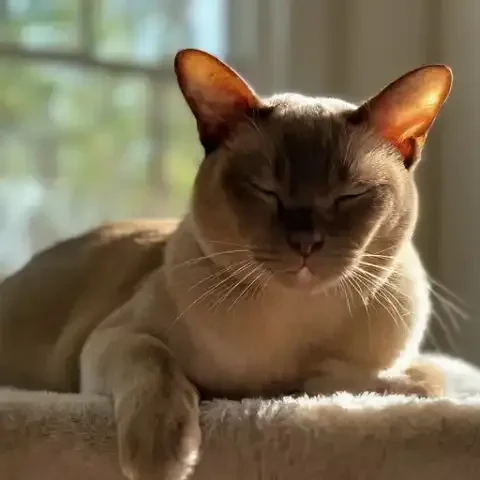Have you ever watched your cat navigate a dimly lit room with the effortless grace of a shadow, or seen them suddenly fixate on a minuscule speck of dust motes dancing in a sunbeam, a speck invisible to your own eyes? Cats have long held a reputation for possessing almost supernatural senses, and their vision is often cited as one of their most remarkable abilities. We speak of their "amazing" night vision and their uncanny ability to spot the slightest movement. But how much of this is truly scientific fact, and how much is simply our anthropomorphic projection of feline mystery? This article aims to move beyond the mystique and delve into the fascinating science behind your cat's vision, to understand exactly what makes it so incredible, and how it perfectly equips them for their unique place in the animal kingdom. While feline vision differs significantly from our own in certain aspects, it is not simply a diminished version of human sight. Instead, it is a highly specialized system, honed over millennia of evolution, specifically tailored to the needs of a crepuscular predator, possessing unique strengths that truly make it remarkable in its own right.
One of the most lauded aspects of feline vision is their legendary ability to see in the dark. This “superpower” of night vision is not mere folklore, but rooted in several key anatomical features of the feline eye. At the heart of this ability lies the retina, the light-sensitive layer at the back of the eye responsible for converting light into electrical signals that the brain interprets as images. Within the retina are two types of photoreceptor cells: rods and cones. Rods are incredibly sensitive to light and primarily responsible for vision in low-light conditions and for detecting motion. Cones, on the other hand, function best in bright light and are crucial for color vision and visual acuity, or sharpness of vision. Compared to humans, cats possess a significantly higher concentration of rods in their retinas. This abundance of rods allows their eyes to capture and process even the faintest glimmers of light, granting them exceptional sensitivity in dimly lit environments. This is the first major key to their night vision prowess.
However, the rod concentration is just the beginning. Cats also possess a remarkable structure called the tapetum lucidum, a Latin term meaning "bright tapestry." This is a reflective layer located immediately behind the retina, acting like a biological mirror within the eye. When light enters a cat's eye and passes through the retina, any light that isn't absorbed by the photoreceptors on its first pass hits the tapetum lucidum and is reflected back through the retina a second time. This effectively gives the light another chance to be absorbed by the rods, maximizing light capture and amplifying the signal sent to the brain. This reflective layer is the reason behind the characteristic "eye shine" we see when a cat's eyes are illuminated in the dark. The tapetum lucidum is made up of guanine crystals, and its iridescent quality is responsible for the eerie, yet beautiful, glow we often associate with cats at night. This brilliant adaptation can boost light sensitivity by as much as 50%, giving cats a significant advantage in low-light hunting and navigation.
Adding to these already impressive adaptations is the remarkable ability of feline pupils to dilate. The pupil, the black aperture in the center of the iris, controls the amount of light entering the eye. In bright light, the pupil constricts to limit the amount of light, preventing overstimulation of the retina. In dim light, the pupil dilates to allow as much light as possible to enter. Cats possess a particularly wide range of pupil dilation compared to humans. Their pupils can expand to become large, almost black orbs, taking up a significant portion of the visible eye, allowing an enormous amount of light to flood the retina in low-light conditions. In bright light, their pupils constrict into narrow vertical slits, minimizing light entry and protecting their sensitive retinas. This extreme pupil range is another critical component of their superior night vision.
Furthermore, the physical structure of the feline eye itself contributes to their light-gathering capabilities. Cats have relatively large corneas and lenses compared to the size of their eyes. The cornea, the clear outer layer of the eye, and the lens, located behind the pupil, work together to focus light onto the retina. Larger corneas and lenses allow for more light to be collected and focused, further enhancing their ability to see in dim conditions.
When we compare cat night vision to human night vision, the differences become stark. While humans can adapt to darkness to a certain extent, our night vision is significantly inferior to that of cats. We also rely primarily on rods for low-light vision, and our pupils dilate to let in more light, but we lack the tapetum lucidum and have a lower concentration of rods compared to cats. This means that in situations where humans struggle to see anything beyond vague shapes and shadows, cats can still discern details, detect movement, and navigate their surroundings with relative ease. However, it's crucial to dispel a common myth: cats do not see perfectly in absolute darkness. Vision, by definition, requires light. In complete darkness, where there is absolutely no light present, even a cat will be unable to see. Their exceptional night vision allows them to see in very low light conditions, conditions where humans are effectively blind, but not in total darkness.
While cats undeniably excel in low-light vision, their daytime vision presents a different picture. Evolution often involves trade-offs, and in prioritizing exceptional night vision, feline daytime vision sacrifices some of the qualities that are prominent in human vision. This trade-off is primarily evident in the concentration of cone cells in their retinas. As mentioned earlier, cones are crucial for color vision and visual acuity in bright light. While cats do possess cones, they have a significantly lower concentration compared to humans. This relative scarcity of cones impacts both their visual acuity and their color perception.
Visual acuity, or the sharpness and clarity of vision, is considerably lower in cats than in humans. This means that in bright light, cats see the world in less sharp detail than we do. Estimates vary, but it is generally accepted that cat visual acuity is somewhere in the range of 20/100 to 20/200, compared to the standard 20/20 vision of humans. This means that what a human with 20/20 vision can see clearly at 20 feet, a cat with 20/100 vision would need to be just 20 feet away to see with the same clarity that a human would see at 100 feet. Put another way, their daytime vision is somewhat blurry compared to ours. This reduced sharpness is a direct consequence of the lower cone density in their retinas and the prioritization of rod cells for low-light sensitivity.
Another area where feline daytime vision differs from human vision is color perception. Humans are trichromatic, meaning we have three types of cones in our retinas, each sensitive to different wavelengths of light, allowing us to perceive a wide spectrum of colors: red, green, and blue. Cats, in contrast, are dichromatic, meaning they possess only two types of cones. For a long time, it was believed that cats saw the world in black and white, a complete misconception that has thankfully been debunked. Modern research suggests that cats likely see primarily in shades of blue and yellow. Their color vision range is roughly similar to that of a human with red-green colorblindness. They can discern blues and yellows relatively well, but struggle to distinguish between reds and greens, which likely appear to them as shades of gray or yellowish-brown. The red end of the color spectrum is largely invisible to them.
This dichromatic color vision might seem like a limitation compared to human trichromatic vision. However, from an evolutionary perspective, it is perfectly adequate for their needs as predators. Prey animals, such as rodents and birds, are not typically brightly colored in reds and greens, the colors that cats struggle to see. Instead, they tend to blend in with their surroundings using browns, grays, blues, and yellows, the colors cats can see. Therefore, their color vision range is still very useful for detecting prey against natural backgrounds. Moreover, motion detection and contrast sensitivity, which cats excel at, are far more critical for hunting success than detailed color vision.
Despite these differences in daytime vision compared to humans, it's important to emphasize that feline daytime vision is still perfectly effective for their lifestyle. While their vision might be less sharp and their color perception limited, it is entirely sufficient for their needs. They can still navigate their environment, recognize familiar individuals, and even hunt effectively during the day. Crucially, their motion detection capabilities remain highly acute even in daylight, and the contrast sensitivity they possess, their ability to distinguish objects from their background, remains excellent. These factors, combined with their sense of smell and hearing, provide them with a complete sensory toolkit for navigating the world, both day and night.
Motion detection is arguably the single most crucial aspect of feline vision, the area where they truly excel and possess a significant advantage as predators. Cats are ambush predators, relying on stealth, patience, and lightning-fast reflexes to capture their prey. The ability to detect even the slightest movement is paramount for their hunting success. Their visual system is exquisitely tuned to movement, even subtle shifts and changes in their peripheral vision. This heightened sensitivity to motion is not just a general perception; it is a finely honed specialization of their visual processing.
Several biological mechanisms contribute to this superior motion detection. Specific retinal cells and neural pathways are dedicated to processing motion information rapidly and efficiently. While the precise details of these pathways are complex, it's understood that cats have specialized cells in their retinas and brain that are particularly sensitive to changes in light and contrast, the very essence of motion. These cells and pathways are wired to react quickly and transmit motion signals to the brain with remarkable speed.
Furthermore, while not a major anatomical difference, cats possess a slightly wider field of view compared to humans, approximately 200 degrees versus our 180 degrees. While this difference might seem small, it subtly aids in their peripheral motion detection. A wider field of view expands their awareness of their surroundings, increasing the chances of detecting movement in their peripheral vision, allowing them to react swiftly to potential prey or threats approaching from the sides.
The manifestation of this exceptional motion detection is readily observable in cat behavior. Watch a cat intently focused on a bird flitting among branches, or a toy mouse darting across the floor. They can track the slightest twitch or tremor with laser-like focus, their eyes locked on the moving object. Even seemingly static objects, if they exhibit the tiniest flicker or shift, will immediately capture a cat's attention. This is why toys that mimic the erratic movement of prey, like feathers on wands or laser pointers, are so captivating to cats. They are triggering this deeply ingrained motion detection system, stimulating their hunting instincts and providing essential mental and physical enrichment. Their ability to notice subtle changes in their environment is also crucial for safety, allowing them to quickly react to potential dangers and navigate complex environments with confidence.
Beyond night vision and motion detection, depth perception and field of view play crucial roles in how cats navigate their world and execute their hunting strategies. Like humans and many other predators, cats possess binocular vision. This means that their eyes are positioned forward-facing on their head, allowing for a significant overlap in their visual fields. The images from each eye are processed by the brain and combined into a single, three-dimensional image. This binocular overlap is the foundation of depth perception, the ability to judge distances and perceive the world in three dimensions. Depth perception is absolutely vital for cats, especially as predators who rely on accurate leaps, precise pounces, and the ability to judge distances when climbing and navigating complex environments.
While their field of view is slightly wider than humans, the area of binocular overlap, the region where both eyes see the same scene, is somewhat narrower in cats compared to humans. Humans have a binocular overlap of around 120 degrees, while cats have a slightly smaller overlap of around 100-120 degrees, depending on head shape and breed variations. While seemingly counterintuitive, this slightly narrower binocular overlap is actually beneficial for cats. It still provides sufficient depth perception for their needs, while the wider overall field of view enhances their peripheral awareness and motion detection capabilities.
The combination of binocular vision, providing depth perception, and a wider overall field of view is perfectly adapted for their hunting and navigational needs. Depth perception is critical for judging distances when leaping onto fences, climbing trees, and accurately striking at prey. Imagine a cat poised to pounce on a mouse. Their binocular vision allows them to precisely judge the distance to their target, ensuring that their leap is accurately aimed. The wider field of view, combined with their exceptional motion detection, gives them a broader situational awareness, allowing them to detect prey or threats approaching from different directions. This combination of visual attributes makes them highly effective hunters in a variety of environments, from open fields to dense undergrowth.
To truly appreciate the incredible nature of feline vision, it's essential to consider it from an evolutionary perspective. The specific characteristics of cat vision are not random traits; they are carefully honed adaptations shaped by millions of years of evolution to suit their specific ecological niche and lifestyle. Cats are crepuscular hunters, meaning they are most active and hunt primarily during dawn and dusk, periods of low-light conditions. Their entire visual system is exquisitely tailored to this crepuscular lifestyle. Their superior night vision allows them to hunt effectively in the dim light of dawn and dusk, giving them a significant advantage over prey that may be less active or less visually adept in these conditions. Their excellent motion detection ensures they can spot even the slightest movements of prey in low light, and their depth perception allows for accurate and successful hunts.
Contrast this with diurnal predators, animals that are active primarily during the day, or herbivores. Diurnal predators, like eagles, often have exceptionally sharp daytime vision and trichromatic color vision, optimized for hunting in bright daylight. Herbivores, on the other hand, often have a wider field of view to detect predators approaching from any direction, but may have less developed depth perception or night vision, as their primary focus is on avoiding predation, not hunting. The differences in visual systems highlight how evolution shapes sensory abilities to perfectly match the ecological needs of each species.
The success of feline vision is undeniable. Cats are incredibly successful predators, found in almost every habitat across the globe. Their visual system, while different from our own, is a testament to the power of natural selection to create perfectly adapted sensory systems. It's not simply a matter of whether cat vision is "better" or "worse" than human vision; it's about understanding that it is incredibly well-suited for their specific lifestyle. It is a specialized system, optimized for their unique niche in the animal kingdom, and in that context, it is truly remarkable and deserving of the term "incredible."
Understanding the nuances of your cat's vision can have practical implications for how you interact with them and create a comfortable and enriching environment in your home. Consider lighting in your home. Cats thrive in low-light environments and are sensitive to harsh bright light. Providing low-light options, especially at night, will be appreciated by your feline companion and allow them to navigate more comfortably. Avoid overly bright or harsh lighting, especially in areas where your cat spends a lot of time.
When choosing toys for your cat, consider their visual strengths. Motion-activated toys are particularly engaging because they tap into their innate motion detection abilities. Toys with colors that cats can perceive well, primarily blues and yellows (and to some extent, greens), might also be more visually stimulating than toys with colors in the red range, which they struggle to see. Experiment with different types of toys and observe your cat's preferences, keeping in mind their visual world.
Understanding feline vision can also help you interpret cat behavior. Their ability to navigate in dim light explains why they seem so comfortable moving around at night, even when you can barely see. Their keen motion detection explains their fascination with flickering lights, moving shadows, and the slightest twitch of a toy. Recognizing their visual strengths and limitations can lead to a deeper appreciation for their actions and help you communicate with them more effectively.
Finally, being aware of potential vision problems in cats is crucial for responsible pet ownership. Just like humans, cats can develop various eye conditions that can affect their vision, such as cataracts, glaucoma, and retinal degeneration. Being observant of your cat's behavior and looking out for signs of vision issues, such as bumping into objects, squinting, excessive blinking, or changes in eye appearance, is important. Regular veterinary checkups, including eye examinations, can help detect and address potential vision problems early on, ensuring your cat maintains good vision and quality of life.
In conclusion, the vision of your feline companion is indeed incredible, not in a mystical or supernatural sense, but in a scientifically fascinating and deeply evolved way. Their exceptional night vision, honed by a high concentration of rods, the light-amplifying tapetum lucidum, and remarkable pupil dilation, allows them to navigate and hunt in conditions where humans are virtually blind. Their acute motion detection, driven by specialized retinal cells and neural pathways, makes them masters of ambush predation. Their dichromatic color vision, while limited compared to human trichromacy, is perfectly adequate for their needs, and their depth perception, facilitated by binocular vision, ensures accurate navigation and hunting precision. Cat vision is not simply a less capable version of human sight; it is a highly specialized and incredibly effective system, perfectly tailored to their crepuscular hunting lifestyle and their place as successful predators. The next time you watch your cat effortlessly traverse a dimly lit room or intently track a moving object, remember the sophisticated and specialized visual world they inhabit, and appreciate the truly incredible nature of their feline vision.







